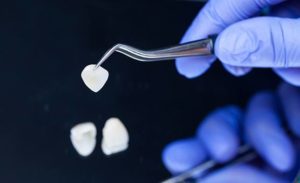DENTISTRY IN THE NEWS – PART 2
March 25, 2024
 Last week I discussed some of the content that was presented in a recent U.S. News & World Report which featured seven pages of information on dentistry. This is a continuation of that.
Last week I discussed some of the content that was presented in a recent U.S. News & World Report which featured seven pages of information on dentistry. This is a continuation of that.
One of the columns in this section of the report entitled, “Guarding Kids’ First Choppers”, mentions that childhood tooth decay is “the most prevalent chronic disease in children”. This is true. According to the report, 28 percent of preschoolers have dental decay. There are many factors that contribute to dental decay, including poor dietary habits and insufficient oral hygiene. This increase is not only in preschoolers but right through high school.
However, the column goes on to say that “dental visits should begin no later than a child’s first birthday”. That might be a little early, but certainly can’t hurt. However, parents should closely inspect their children’s teeth. If there is anything that is seen that is not tooth-colored or doesn’t look right, the child should be seen by a dentist. Pediatric dentists are one option but many general family dentists are more than willing to see children. If there are issues that warrant a pediatric specialist, the child can be referred.
Having said that, there are many newer lines of thinking in regards to child development. Things such as tongue attachments (tongue tie) should be evaluated early, as this is often a relatively easy fix. Earlier orthodontic intervention, to aid in better dental development and airway health, is also a newer trend. These are things that need to be evaluated by someone who is qualified in that specific area, which is often an airway-minded pediatric dentist, general dentist and orthodontist.
Another column in the report entitled, “The Wisdom on Wisdom Teeth”, says “the latest data suggests that as many as 80 percent of people will develop problems with their wisdom teeth”. This is true. In most people, wisdom teeth either will not fit with all of the other teeth in the mouth or they erupt crowded. This may not cause a problem right away, but because they are difficult to clean, they either get decay or cause periodontal problems with the neighboring teeth. The current line of thinking is to remove these teeth between the ages of 16-18, or before the roots are fully developed. This generally makes for a much less traumatic surgery.
In the article entitled, “Taking the Cost Out of the Bite”, it is discussed what to do if you don’t have dental insurance. One of the suggestions is “to consider purchasing an individual dental policy”, and the other is to look for discount programs which “give members 10 to 60 percent off at certain providers”. This is tricky. If you don’t get dental insurance from your employer or are not covered under a spouse’s plan, you really have to look at the numbers and also at what you are entitled to with particular plans. If it seems too good to be true, it probably is.
The cost of purchasing your own indemnity dental insurance plan usually outweighs the benefits. Most, if not all dental insurance plans have annual maximums which average $1000 per year. You pay the premium to the insurance company, which might be $750 a year, but then you only get $1000 in benefits. It may make sense for families but usually not for individuals. As far as the “discount plans” the column refers to – this is a buyer beware. These plans force you to choose a dentist from a list, and this list is usually not very long. It is important to consider the quality of care, or at least the level of care you desire.
Dental health is important to overall health on many different levels. Make it a priority!
Dr. St. Clair maintains a private dental practice in Rowley dedicated to health-centered family dentistry. He has a special interest in treating snoring, sleep apnea and TMJ problems. If there are certain topics you would like to see written about or questions you have please email them to him at jpstclair@stclairdmd.com
DENTISTRY IN THE NEWS – PART 1
March 18, 2024
A recent U.S. News & World Report featured seven pages of information on dentistry. Although I was surprised that most of the information was accurate, as the media often skews the facts to make a point, there were a few things that I felt needed clarification.
The first article highlights the fact that 75% of adults have some form of periodontal disease. This is true. It also mentions many of the known facts with regards to gum disease and systemic health. One of those is that uncorrected gum problems can make it more difficult for diabetics to control their blood sugar, and in turn worsen their gum problems. This is also true.
With regards to brushing, the article states, “Scrubbing with fluoride toothpaste robs oral bacteria of sustenance.” This is true to some extent but the term “scrubbing” is not completely accurate. Proper brushing technique with either a very soft manual toothbrush or good electric toothbrush is a more accurate description. Also, fluoride, in and of itself, is not truly anti-bacterial. Although it is felt that its anti-cavity action is related mainly to effects on mineral phases of teeth and on the process of remineralization (strengthening enamel), research does show that fluoride also has important effects on the metabolism of bacteria in dental plaque. There are other ingredients in toothpastes with and without fluoride that are more anti-bacterial, but it is the removal of plaque manually that is most important, even without toothpaste.
With regard to electric toothbrushes, the article insinuates that “basic” and “cheap” ($7) models are as effective as more expensive models. This is false. Although you do not have to buy the most expensive model available, there is a huge difference in effectiveness between a $7 battery-operated toothbrush and a $70 wall-charged one.
The article states, “Only floss can reach below the gum-line.” This is not completely true. Proper toothbrush technique gets below the gum-line on two sides of the teeth. Floss is important for removing debris between teeth. A water pik is probably most effective for cleaning the non-brushable areas in the mouth.
For combating bad breath, the article’s first suggestion is to “brush your tongue.” Although it mentions the use of a tongue scraper, it only states the use of this device if your toothbrush makes you gag. The fact of the matter is that a tongue scraper is 100% more effective in removal of the nasty bacteria on your tongue. If the toothbrush makes you gag so will the tongue scraper. One trick is to scrape your tongue while you are exhaling.
An article in the report entitled, “21st-Century Dentistry” highlights the use of lasers in treating gum problems. The beginning of the column gets you revved-up to believe that this is the best thing since sliced bread, but the end of the article states differently. “It is unlikely to fully replace traditional gum surgery anytime soon. The laser therapy isn’t demonstrably superior to surgery, researchers recently reported in the Journal of Periodontology.”
To be continued…….
Dr. St. Clair maintains a private dental practice in Rowley dedicated to health-centered family dentistry. He has a special interest in treating snoring, sleep apnea and TMJ problems. If there are certain topics you would like to see written about or questions you have please email them to him at jpstclair@stclairdmd.com
INTEGRATED HEALTH CARE
March 11, 2024
 Dentistry is one of those things in life….as with most things…. that people view in different ways. Some are interested in their appearance, some are interested in their health, some both, and others none of the above. A major role of health care providers is to make patients aware of the possibilities to improve their quality of life. When our services are perceived as a commodity, expectations are often not achieved.
Dentistry is one of those things in life….as with most things…. that people view in different ways. Some are interested in their appearance, some are interested in their health, some both, and others none of the above. A major role of health care providers is to make patients aware of the possibilities to improve their quality of life. When our services are perceived as a commodity, expectations are often not achieved.
Dentists play a key role in screening patients for many disorders relative to nutrition and in providing appropriate referrals into the health care system. Although the importance of integrating diet and nutrition guidance into dental care has been advocated for decades by educators, it continues to be ignored except by a handful of prevention-oriented practitioners.
Many of the world’s most significant health problems are linked to poor dietary practices, including over-nutrition and under-nutrition. Nutrition plays a fundamental role in health, and dental professionals have the opportunity to be a critical link between discovery and wellness.
There is a great deal of evidence linking oral infections, including periodontal disease, nutrition and immunological response. We have clear evidence linking oral disease with adverse pregnancy outcomes, diabetes, cardiovascular disease and stroke. In addition, obesity, which is an epidemic facing our country, is significantly affecting the incidence of diabetes, cardiovascular disease and overall lifespan. We know there are direct connections between these problems and oral disease. What is the role of the dentist? Should the dentist just be a tooth fixer?
As the body of data linking systemic health conditions and oral infection grows, this expanded understanding will result in more profound discoveries. However, we know right know that the scientific bridge between oral disease and systemic health is often mediated by diet and nutrition.
The beneficiary of this profound evidence should be you, the dental patient. It should not only be the responsibility of the physician or specialized nutritionist to incorporate this information into practice; the dentist should be playing a key role.
For the most part, the dentist is the only one who examines the mouth. It used to be that the dentist only looked at the teeth and only fixed problems if they arose. Most dentists screen for periodontal, or gum, problems as well as oral cancer. The trend is to address these problems earlier than ever before. Identifying developmental issues related to facial growth during childhood, for example, is much more than prescribing orthodontics. Lives can be changed with early intervention.
People tend to have ingrained in their head that the dentist just looks at the teeth and treatment should be the same as 25 years ago. The fact of the matter is, things change and there are no two dentists who practice identically. Each individual’s philosophy of care comes from personal experience, review of literature and the type and amount of continuing education taken.
One thing we all hope is that our health care provider, dentist or physician, has our best interest in mind. There is room for improvement in the communication between all health care providers. As science continues and evidence grows, it is the responsibility of all health care providers to work towards a more integrated health care system.
Dr. St. Clair maintains a private dental practice in Rowley dedicated to health-centered family dentistry. He has a special interest in treating snoring, sleep apnea and TMJ problems. If there are certain topics you would like to see written about or questions you have please email them to him at jpstclair@stclairdmd.com
FULL-SPEED FORWARD
March 4, 2024
 I’m sure we all agree that keeping up with technology is not easy. From computers to cell phones to cars, and everything in between, changes take place at lightning speed. No matter what we buy, there is always something right around the corner, or already there, that is better.
I’m sure we all agree that keeping up with technology is not easy. From computers to cell phones to cars, and everything in between, changes take place at lightning speed. No matter what we buy, there is always something right around the corner, or already there, that is better.
I purchased a digital x-ray system back in January of 2008 to replace film and chemicals to develop. By June of the same year, the same company came out with a smaller, thinner sensor. This didn’t make mine obsolete, but my $10,000 investment made six months before could now be purchased for half the price. I thought I was “jumping in” at the right time.
As with most, if not all industries, technology is sweeping the dental field. We are digitizing everything. Offices that are not already “paperless” are moving in that direction. Automated systems for appointment confirmation via text or email, scheduling appointments, paying bills online, filling out online forms, and digital patient charts have been commonplace in dental offices for a while.
Digital radiology is transforming the way we treatment plan and deliver services such as dental implants. This 3-Dimensional technology allows accurate evaluation of biological structures to provide almost pinpoint placement of dental implants that may not have been able to be done using traditional methods. Notice I said “almost” pinpoint accuracy. It’s still not perfect, but it keeps getting better and better.
You may be aware that some dental offices can make crowns chairside without the use of gooey impression materials or the need of a dental laboratory. This technology has been around for over 25 years. The first generation of this technology was pretty cool back in the day, but delivered less than stellar results. Today, it is safe to say, this technology has greatly improved, continues to get better, and is not going away.
While the technology has gotten significantly better, there are still limitations. Currently, this technology uses a reduction method to fabricate restorations. This means that the restoration is milled from a solid block of material. The material choices are somewhat limited but getting better. What’s next? Maybe 3-D printing of whatever material you would like to use.
I read an article recently about 3-D printing technology where the CEO of this particular company working on dental applications said, “If 3D printing hopes to break out of the prototyping niche it has been trapped in for decades, we need to find a disruptive technology that attacks the problem from a fresh perspective.” I think this technology will be a game-changer.
I have always struggled with when to “jump-in” with certain technologies. It’s not an easy decision. The high cost, the learning curve, and knowing there is always something better right around the corner have been the barriers for me. The more I read about what is on the horizon, the more I want to wait for the “next best thing.”
Dentistry is moving fast forward in technological advances. However, two things come to mind about technology and dentistry. The first, is to keep in mind that sometimes the best option may be an older model. For example, gold is still used in dentistry, and definitely has a place in certain circumstances. The second thing, is that someone has to pay for all this advanced dentistry, and dental insurance companies haven’t changed their model since the 1970’s. Many insurance companies will pay for more of your filling if get a “silver” one than a tooth-colored one.
First, we need to find “disruptive technology” to help prevent dental disease and treat it earlier and better. Prevention should be the focus. We also need to have a disruptive revolution of dental insurance. The current model is a no-win situation, except for the insurance companies.
Dr. St. Clair maintains a private dental practice in Rowley dedicated to health-centered family dentistry. He has a special interest in treating snoring, sleep apnea and TMJ problems. If there are certain topics you would like to see written about or questions you have please email them to him at jpstclair@stclairdmd.com







